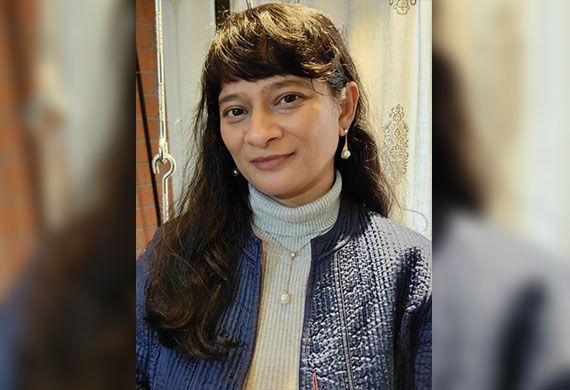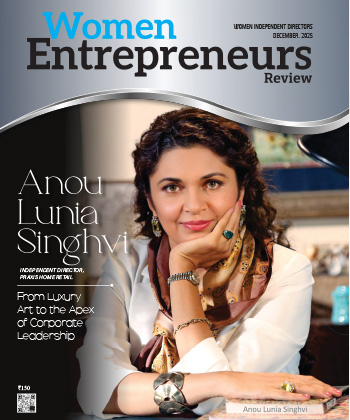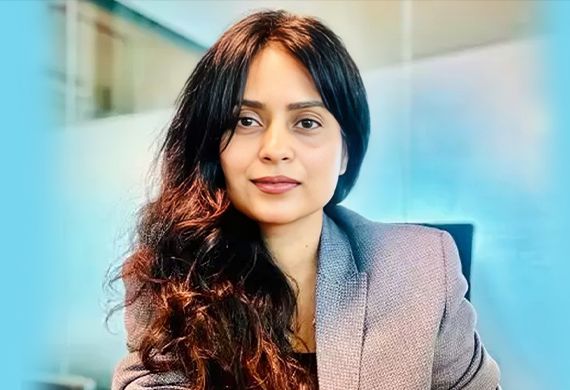Leaders

Ar. Sudiksha Parekh: Crafting Original, Personalized & Functional Structures
Ar. Sudiksha Parekh
Founder, Imprints Architects
Navi Mumbai
Architecture extends far beyond designing structures. When viewed through a broader lens, it has a lasting impact on the user. Imprints often compare design to a human body which has geometry, balance, function, but we try to find and incorporate the soul in every design which identifies Imprints from others and creates individuality in each design. Across the globe, architects are translating abstract concepts into tangible realities, pushing the boundaries of innovation, redefining architecture’s ability to impact people’s lives in meaningful ways.
An architect driven by a passion for creation and innovation is Sudiksha Parekh. The founder of Mumbai-based architecture firm, Imprints Architects, Sudiksha believes that architecture is much more than physical structures. She prioritizes the clients’ vision and excels at giving her designs the personal touch, a philosophy also signified in the company’s thumbprint logo.
As a Gold medalist from Centre of Environment and technology, CEPT, Ahmedabad, Sudiksha’s architectural education has been shaped by esteemed mentors such as B.V. Doshi, Gurjit Singh Matharoo, and Miki Desai. Drawing inspiration from these stalwarts, her design philosophy revolves around bringing clients’ vision to life through a structured yet client-centric approach. For Sudiksha, architecture is not just about aesthetics but about meaningful, functional and experience-rich spaces for life.
What motivated you to pursue architecture?
From an early age, I was driven to create and innovate, preferring to forge my own path rather than follow conventions. My passion for originality led me to design unique objects and explore unconventional ideas, reinforcing my belief in my creative potential.
Recognition and appreciation further fueled my journey into architecture. Choosing architecture was about more than just a career, it was about self-expression. I realized this field would allow me to showcase my individuality, embrace innovation, and carve out my own creative path.
The key to overcoming challenges is patience, perseverance and the commitment to stay true to our vision and thought process
Take us through your journey in the field of architecture. What led you to establish Imprints Architects?
My architectural education was shaped by esteemed mentors like B.V. Doshi, Gurjit Singh Matharoo, and Miki Desai. Observing the work of well-known architects fuelled my ambition to create impactful designs and pushed me to strive for excellence in my own architectural journey.
Upon visiting projects and sites of architects, I realised their success stemmed from independent practice. I knew I had to establish my own firm to bring my distinct design philosophy to life.
Starting my own firm was not easy. Mumbai is a city that brought cultural and professional challenges. Establishing Imprints Architects in Mumbai meant learning everything from scratch, from registrations to business operations. The city’s dynamic environment welcomes innovation, and with hard work and teamwork, we scaled successfully.
Through persistence and goodwill, I was able to earn client’s trust and industry recognition. By deeply engaging with clients’ requirements, I integrated their vision into design. This commitment fostered trust, strengthened relationships, and propelled success.
What are some defining moments in your professional journey and how have these experiences shaped your leadership and design philosophy?
I believe architecture and entrepreneurship are distinct skillsets. Excelling in architecture is one thing, but navigating entrepreneurship is a separate challenge. It’s a path of continuous learning and self-growth beyond formal training.
Early on, I recognized that leaders possess unique perspective. Architecture school reinforced this, offering insights from visionary architects who shaped my thoughts. True leadership goes beyond individuality, it requires humility, connection, and the ability to make others feel heard, essential in both architecture and business.
Initially I believed that design was about geometry, balance, and function. I began to see it as more than a physical form, but as an experience that shapes emotions and enhances spaces. At Imprints Architects, we view architecture as a deeply personal journey. Our thumbprint logo symbolizes our commitment to creating space that are as unique as the people who inhabit them.
What are some challenges facing the architecture industry today? How do you overcome these roadblocks?
The first few projects at Imprints Architects required strong client communication to align vision. Understanding cost, maintenance, and execution minimized conflicts, but the emotional investment was harder to navigate. The arrival of COVID added complexity, yet our commitment to excellence and adaptability never wavered. Working in extreme conditions required more than just professionalism and discipline, it demanded perseverance.
The key was believing in the process, staying committed, and pushing forward with the confidence that success would follow.
For us, design is about comfort and emotional well-being, which is why, in projects like an orphanage, we focused on creating a home-like atmosphere through thoughtful design that enhances well-being. The key to overcoming challenges was patience, perseverance and the commitment to stay true to our vision and thought process.
Which fundamental principles guide your leadership and decision-making approach as an architect?
The architecture industry once felt male-dominated, especially in government offices and on-site roles. With fewer women in the field, leadership often felt empowering but in solitary, She believes in collective growth. Thus, the importance of inclusive and group-based decision-making ensured broader acceptance and stronger outcomes. Valuing every team member’s input created a comfortable space, that enhanced creativity and encouraged new solutions for problem-solving.
I have learnt that successful projects stem from leaders who prioritize collective goals over personal recognition and perspective. By acknowledging labourers experience and bridging gaps between them and clients, we foster mutual respect and create a more informed, collaborative, and effective work environment.
How do you foresee the Indian architecture landscape evolving in the future?
The approach to design has shifted significantly, with more professionals recognizing its dynamic evolution. There is a growing awareness of design’s fluid nature. The challenge now is to harmonize diverse viewpoints in architectural and interior innovation.
Beyond aesthetics, variable factors such as climate, heat and population present greater challenges for designers. Integrating India’s architectural heritage into modern design can create structures better suited to local climate and materials, fostering more organic approach.
The focus should now lie in how to strategically integrate design elements for sustainability and functionality. Sustainability and AI are driving the future of architecture. AI presents new opportunities for efficiency and innovation, making it a valuable addition to design process.
Ar. Sudiksha Parekh, Founder, Imprints Architects
Ar. Sudiksha Parekh brings in a fresh perspective to architecture with meaningful and experience-rich places. She innovates and meticulously executes to create a balance of creativity and technical mastery to celebrate design.
Most Viewed
- 1 Women's Health Startup HerMD Closing Doors Amid Industry Challenges
- 2 5 Famous Women in Indian Armed Forces
- 3 Saudi Women No longer Require Male Permission for Clothing Choices, says Prince MbS
- 4 Kolkata Medtech Startup Innovodigm Raises Rs 5.5 Crore Seed Funding Led by IAN Group
- 5 Yamunanagar's Kashish Kalra Honoured after Securing 111th Rank in UPSC Civil Services Exam
- 6 Madurai Appoints Its First Woman Corporation Head
- 7 IAS Vijayalakshmi Bidari Appointed as the new Nagpur Divisional Commissioner
- 8 American Entrepreneur Lucy Guo Overtakes T Swift to become Youngest Female Billionaire
- 9 ICC Women's World Cup 2025 Trophy Showcased at Indore's Holkar Stadium
- 10 Aparna Saxena's Beauty Venture AntiNorm Launches in India
- 11 Vidya Nataraj Co-Founded BlueStone Jewellery & Lifestyle files IPO
- 12 5 Women Freedom Fighters of India
- 13 Dr. G Krishnapriya appointed as CEO for Trichy
- 14 M3M & Sirona Partner to Introduce Menstrual Hygiene Vending Machines in 15 Locations
- 15 Punjab Govt launches SHE Cohort 3.0 Supporting Tech-led Women Startups
- 16 Indian origin Lawyer, Sweena Pannu appointed as the US New Superior Court Judge
- 17 The Aurora Tech Award recognizes 4 Indian Women-led Startups
- 18 Kerala's Republic Day parade featured an all-female tableau
- 19 Manisha Kabbur Becomes Karnataka's First Woman International Karate Coach
- 20 Director K. S. Ravikumar's Daughter Maalica Ravikumar Launches Life Coaching Company 'Evergrowth Academy' for Women
- 21 Leezu's Raises Pre-Seed Funding to Accelerate Growth in Sexual Wellness Industry
- 22 Sattu: Super-easy summer drink for PCOS gut healing
- 23 Swathi Nelabhatla creates Sitha App, India's First Women-Exclusive Gig Platform
- 24 7 Timeless Female Kathak Dancers & their Iconic Legacies
- 25 Meet 7 Iconic Women Architects of Modern India & their Most Impactful Work
- 26 This Woman-led Insuretech Startup is Helping Bridge the Education Financing Gap in India
- 27 Women Leaders Share Lessons Learnt from India Women's WC Win
- 28 5 Enterprising Women Founders Powering Singapore's Tech & Innovation Landscape
- 29 4 Women. 4 Stories. One Vision for Smarter, Stronger Healthcare
- 30 Global Gender Gap Narrows to 68.8%, But Full Equality 123 Years Away: WEF Report 2025
- 31 Changemakers: 7 Women Entrepreneurs Taking the Make in India Movement Forward
- 32 Meet Lucy Guo, The Youngest Self-Made Female Billionaire Disrupting Tech
- 33 How Women are Driving India's Festive Online Shopping Surge






